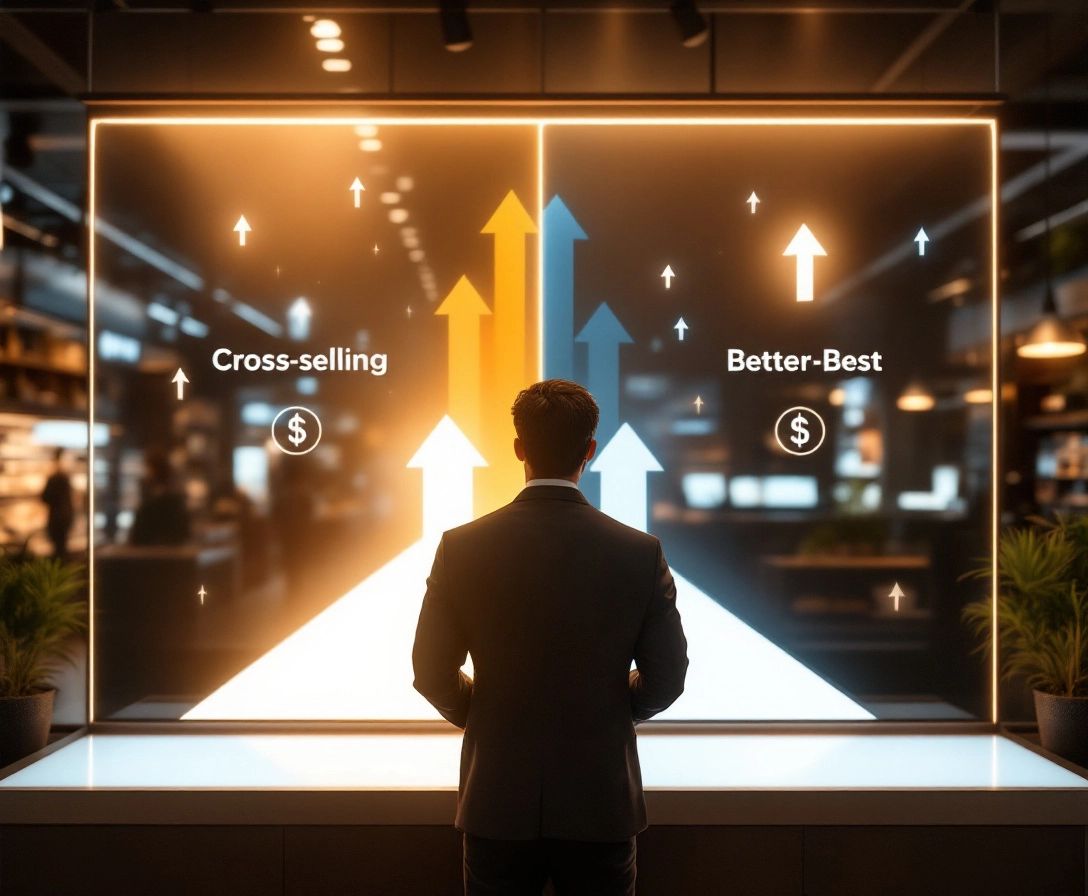Cross-Selling vs Upselling: Which Strategy Will Skyrocket Your Revenue?
October 27, 2024

Introduction

In the realm of sales, certain strategies are used to increase revenue and improve the overall experience for customers. Two such strategies, often used interchangeably, are cross-selling and upselling. While both can be quite successful, they take different approaches to the sales process.
It's important for businesses that want to reach their full sales potential to understand the distinction between cross-selling and upselling. It's about identifying opportunities to offer customers more value while guiding them towards purchases that best suit their needs.
What is Cross-Selling?

Cross-selling is a sales tactic where you suggest additional products or services that complement what the customer is already buying. For example, a customer orders a latte at a coffee shop. A cross-sell would be to offer them a pastry to go with their drink.
The important thing here is relevance. Cross-selling shouldn't be about pushing random products; it's about understanding your customer's needs and showing them items that enhance their initial purchase.
Examples of Cross-Selling in Action:
- Online Retailers: Recommending matching accessories, like a belt or scarf, to someone buying a dress.
- Electronics Stores: Offering a warranty extension or insurance plan with a new laptop purchase.
- Software Companies: Recommending additional software integrations or features to a client who has a basic plan.
Cross-selling, when done correctly, benefits both the customer and the business. Customers feel understood and businesses enjoy larger purchases and stronger customer relationships.
What is Upselling?
While in cross-selling, you offer related products, upselling focuses on increasing the value of the customer's existing purchase. Imagine a customer is about to buy a basic coffee machine online. An upsell would be offering them the option to upgrade to a model with a built-in grinder and milk frother.
Essentially, upselling guides customers towards a better version of the product or service they've chosen. It's about showing the added benefits they'll receive by spending a bit more.
Examples of Upselling Techniques:
- Software Subscriptions: Encouraging a user on a free trial to upgrade to a paid plan with more features and storage space.
- Restaurants: A server suggesting a larger portion size or a premium side dish with a diner's main course.
- Airlines: Offering passengers the opportunity to upgrade to a business class seat with extra legroom and perks.
Effective upselling hinges on understanding the customer's needs and showing how a higher-priced option provides a solution that's more aligned with those needs. When done right, both customers and businesses benefit – customers feel like they're getting more for their money, and businesses see an increase in their average sale.
Key Differences

Both cross-selling and upselling aim to increase revenue, but they go about it in different ways. Here’s a closer look at their key differences:
Focus:
- Cross-selling focuses on offering related products or services to complement the initial purchase.
- Upselling aims to encourage customers to purchase a higher-priced or upgraded version of the product they're interested in.
Value Proposition:
- Cross-selling emphasizes enhancing the initial purchase. The value lies in showing customers how additional products can improve their overall experience or solve related needs.
- Upselling highlights increased benefits and value. The focus is on showing how a premium option offers more features, better performance, or greater convenience.
Example Scenario:
Imagine a customer buying a new smartphone:
- Cross-selling: Offering a phone case, screen protector, or headphones.
- Upselling: Suggesting a larger storage capacity, a faster processor, or a model with a better camera.
Impact:
- Cross-selling tends to have a larger impact on customer lifetime value (CLV). By expanding revenue streams and fostering customer loyalty, cross-selling encourages repeat purchases and strengthens customer relationships.
- Upselling typically has a more immediate impact on average order value (AOV). By guiding customers towards higher-priced options, upselling directly increases the value of individual transactions.
Cross-selling is about breadth, offering a wider range of products to meet various needs. Upselling, on the other hand, is about depth, encouraging customers to invest in a more premium version of their chosen product. Both strategies, when executed effectively, can lead to higher revenue and happier customers.
Implementation Strategies
Knowing the difference between cross-selling and upselling is one thing, but putting them into action effectively is another. Here's how to implement both strategies in a way that works well for your customers:
Cross-Selling Strategies:
- "Frequently Bought Together" Sections: This classic tactic, often seen on e-commerce sites, subtly nudges customers towards complementary products by showing what others have purchased alongside their chosen item.
- Bundled Deals and Discounts: Offering package deals with a slight discount for buying multiple related items can be very effective. It makes customers feel like they're getting good value and encourages larger purchases.
- Personalized Recommendations: Use customer data and browsing history to recommend relevant products. If someone buys running shoes, suggest athletic socks or running apparel.
- Post-Purchase Emails: After a purchase, send a follow-up email thanking the customer and suggesting related products they might find useful.
Upselling Strategies:
- Product Comparison Charts: Clearly showcase the differences in features and benefits between various product tiers. This allows customers to easily see what they gain by upgrading.
- Premium Product Placement: Strategically position your higher-priced items in prominent locations on your website or in your store.
- Limited-Time Offers and Upgrades: Create a sense of urgency by offering exclusive upgrades or discounts for a limited time.
- Highlighting Customer Reviews: Feature positive reviews that specifically mention the upgraded features or benefits of the premium product.
Remember, the key to both cross-selling and upselling is to be helpful, not pushy. Focus on providing value and showing how these additional offerings can make the customer's overall experience better.
Best Practices and Conclusion

Mastering cross-selling and upselling is about finding that balance between meeting customer needs and driving revenue. It's about being strategic and customer-centric. Here are some important rules to keep in mind:
Timing is Everything
- Don't overwhelm: Bombarding customers with too many options at once can be off-putting.
- Strike while the iron's hot: The best time for cross-selling is during or right after a purchase when the customer is already engaged.
- Strategic upselling: Offer upgrades at logical points, like when a customer is comparing features or about to checkout.
Personalization is Key
- Know your customer: Use data and insights to tailor recommendations. Suggest products or upgrades that genuinely align with their needs and preferences.
- Don't assume: What works for one customer might not work for another. Segment your audience and personalize your approach.
Value, Value, Value
- Highlight the benefits: Clearly articulate how the additional product or upgrade enhances the customer's experience or solves a specific problem.
- Don't just focus on price: Emphasize the value proposition. Explain how the upgrade offers greater convenience, enhanced performance, or long-term savings.
Make it Seamless
- Easy integration: Ensure cross-sold products are easy to add to the cart and that upgrade options are clearly presented.
- Simplify the process: The easier it is for customers to say "yes," the more likely they are to convert.
Effectively using cross-selling and upselling can significantly improve your business. By focusing on relevance, value, and a smooth customer experience, you can boost revenue, cultivate customer loyalty, and drive sustainable growth.
Want to improve your upselling and cross-selling strategies? Checkout Links is a powerful Shopify app that empowers you to create personalized, shoppable links that lead customers directly to pre-filled carts and exclusive offers. Explore Checkout Links today and unlock the full potential of your online store.
 Checkout Links
Checkout Links



